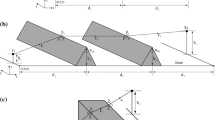Abstract
This paper describes an improved model for multiple building diffraction modeling based on the uniform theory of diffraction. A well-known problem in conventional uniform theory of diffraction (CUTD) is multiple edge transition zone diffraction. Here, higher order diffracted fields are used in order to improve the result. Hence, we use higher order diffraction coefficients to improve a hybrid physical optics (PO)-CUTD model, the results show that the new model can correct errors of the PO-CUTD model. Therefore, the proposed model can find application in the development of theoretical models to predict more realistic path loss in urban environments, when multiple building diffraction is considered.






Similar content being viewed by others
References
Bertoni, H. L. (2000). Radio propagation for modern wireless systems. Englewood Cliffs, NJ: Prentice-Hall.
COST 231 Digital mobile radio toward future generation systems, European Commission, Brussels, Belgium, 1999.
Zhang, W. (2000). Fast two-dimensional diffraction modeling for site-specificpropagation prediction in urban microcellular environments. IEEE Transactions on Antennas and Propagation, 49(2), 428–436.
Wolfish, J., & Bertoni, H. L. (1988). A theoretical model of UHF propagation in urban environments. IEEE Transactions on Antennas and Propagation, 36(12), 1788–1796.
Saunders, S. R., & Bonar, F. R. (1991). Explicit multiple building diffraction attenuation function for mobile radio wave propagation. Electronics Letters, 27(14), 1276–1277.
Saunders, S. R., & Bonar, F. R. (1994). Prediction of mobile radio wave propagation over buildings of irregular heights and spacings. IEEE Transactions on Antennas and Propagation, 42(2), 137–144.
Neve, M. J., & Rowe, G. B. (1994). Contributions toward the development of a UTD-based model for cellular radio propagation prediction. Proceedings IEE Microwave, Antennas Propagation, 141(5), 407–414.
Arablouei, R., & Ghorbani, A. (2002). A new UTD-based model for multiplediffractions by buildings. In Proceedings 3rd international conference microwave and milimeter wave technology, 484–488, St. Petersburg, Russia.
Rodríguez, J. V., Molina-García-Pardo, J.-M., & Llácer, L.-J. (2005). An improved solution expressed in terms of UTD coefficients for the multiple-building diffraction of plane waves. Vol: IEEE Antennas and Wireless Propagation Letters. 4.
Tajvidy, A., & Ghorbani, A. (2008). A new uniform theory-of-diffraction-based model for the multiple building diffraction of spherical waves in microcell environments. Electromagnetics, 28, 375–388.
Torabi, E., Ghorbani, A., & Tajvidy, A. (2009). A modified diffraction coefficient for imperfect conducting wedges and buildings with finite dimensions. IEEE Transactions on Antennas and Propagation, 57(4), 1197–1207.
Ghorbani, A., Tajvidy, A., Torabi, E., & Arablouei, R. (2011). A new uniform theory of diffraction based model for multiple building diffraction in the presence of trees. Electromagnetics, 31, 127–146.
Holm, P. D. (2004). Calculation of higher order diffracted fields for multiple-edge transition zone diffraction. IEEE Transactions on Antennas and Propagation, 52(5), 1350–1355.
Holm, P. D. (2000). A new heuristic UTD diffraction coefficient for no perfectly conducting wedge. IEEE Transactions on Antennas and Propagation, 48(8), 1211–1219.
Author information
Authors and Affiliations
Corresponding author
Rights and permissions
About this article
Cite this article
Tajvidy, A., Pourmina, M.A., Naser-Moghadasi, M. et al. An Improved UTD Based Model for the Multiple Building Diffraction of Plane Waves in Urban Environments by Using Higher Order Diffraction Coefficients. Wireless Pers Commun 72, 2577–2586 (2013). https://doi.org/10.1007/s11277-013-1167-z
Published:
Issue Date:
DOI: https://doi.org/10.1007/s11277-013-1167-z




